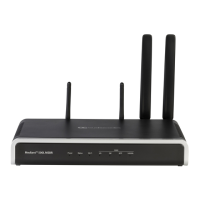User's Manual 420 Document #: LTRT-10466
Mediant 500L MSBR
considers the IP destination as unavailable and attempts to re-route the call to an
alternative destination. For more information on the IP connectivity methods and on
viewing IP connectivity status, see ''IP Destinations Connectivity Feature'' on page 418.
The table below shows an example of alternative routing where the device uses an
available alternative routing rule in the Outbound IP Routing table to re-route the initial Tel-
to-IP call.
Table 27-4: Alternative Routing based on IP Connectivity Example
Destination
Phone Prefix
IP Destination
IP Connectivity
Status
Rule Used?
Main Route
40 10.33.45.68 "No Connectivity" No
Alternative Route #1
40 10.33.45.70 "QoS Low" No
Alternative Route #2
40 10.33.45.72 "ok" Yes
The steps for configuring alternative Tel-to-IP routing based on IP connectivity are
summarized below.
To configure alternative Tel-to-IP routing based on IP connectivity:
1. In the Outbound IP Routing table, add alternative Tel-to-IP routing rules for specific
calls.
2. In the Routing General Parameters page (Configuration tab > VoIP menu > GW and
IP to IP > Routing > General Parameters), do the following:
a. Enable alternative routing based on IP connectivity, by setting the 'Enable Alt
Routing Tel to IP AltRouting' (Tel2IPEnable) parameter to Enable.
b. Configure the IP connectivity reason for triggering alternative routing, by setting
the 'Alt Routing Tel to IP Mode' parameter (AltRoutingTel2IPMode) to one of the
following:
♦ SIP OPTIONS failure
♦ Poor QoS
♦ SIP OPTIONS failure, poor QoS, or unresolved DNS
c. The device plays a tone to the Tel endpoint (for analog interfaces) whenever an
alternative route is used. This tone is played for a user-defined time configured by
the 'Alternative Routing Tone Duration' parameter.
27.5.2 Alternative Routing Based on SIP Responses
The device can perform alternative routing based on the received SIP response code (i.e.,
4xx, 5xx, 6xx, or 8xx). If you have configured this response code in the Reasons for Tel-to-
IP Alternative Routing table, the device attempts to re-route the call to an alternative
destination, if configured. You can configure up to 10 SIP response codes in the Reasons
for Tel-to-IP Alternative Routing table.
Typically, the device performs alternative routing when there is no response at all to an
INVITE message. This is done after a user-defined number of INVITE re-transmissions,
configured by the SIPMaxRtx parameter. In such a scenario, the device issues itself the
SIP response code 408 (Request Timeout). You can also configure the device to perform
alternative routing for the following proprietary response codes that are issued by the
device itself:
805 IP Profile Call Limit: The device generates this response code when Call
Admission Control (CAC) limits are exceeded for an IP Group. The CAC rules are
configured in the IP Profile table (see ''Configuring IP Profiles'' on page
332). When
this occurs, the device sends a SIP 480 (Temporarily Unavailable) response to the
SIP entity.





